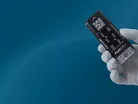Fluxergy: reducing COVID-19 among the homeless

Medtech company Fluxergy developed a 1 hour COVID-19 test back at the very start of the pandemic in March 2020. Now the company's testing platform is being used to reduce the spread of COVID-19 among the homeless and other underserved communities. We spoke to Tej Patel, Fluxergy’s President and Cofounder, and Dr. Davey Smith, Chief of Infectious Diseases at University of California San Diego, who answered our questions about how the platform works.
What is Fluxergy's key mission?
Our goal from the start has always been to increase accessibility to health testing whether for healthcare in low and middle-income countries or from a one health perspective.
What sets Fluxergy apart from other testing methods?
Current lab costs are prohibitive for preventative screening and their timeline for getting results back have created challenges when it comes to making a differential diagnosis for treatment.
Our system is looking for the DNA or RNA of an organism. Taking what they are doing in the lab and bringing it to a smaller and easier to use form factor, we're automating down what can be a 3+ hour process in a lab to less than one hour while taking out the logistics.
How does the testing platform help to curb COVID-19?
Fluxergy has launched its platform to environments with rapid testing needs including emergency rooms, outpatient procedures, urgent care, delivery ward, workplace screening, mobile testing, community level testing settings, school reopenings, and in travel certifications.
For testing to be effective and for transmission to be minimised (especially with surges caused by the Delta variant and continued rises in cases in developing countries), as many people as possible must be screened as often as possible. This way, we can track who has tested positive, where they’ve been, and the people who have come into contact with the carrier.
Is it suitable for other infectious diseases?
Fluxergy's PCR technology can extend itself to detection of any biological organisms via DNA or RNA. Fluxergy plans to develop several other ID assays including a respiratory panel that will target flu, COVID-19 and RSV as well as a delivery ward admit panel that can detect group B strep alongside COVID-19. It is truly a platform approach that can target vector-borne and tropical diseases like TB to food-borne pathogens like salmonella.
What makes Fluxergy well equipped to help underserved populations?
The Fluxergy platform's speed, accuracy, price-point, portability, and ease-of-use are core reasons why it is making an impact in underserved communities. Communities without testing or logistical infrastructure do not have the ability to provide timely testing, and struggle with patient follow-up.
Pandemics and community spread diseases will always hit disadvantaged populations the hardest, as seen by this pandemic. Typically point of care has struggled to make an impact in these communities because each device only conducts one type of test and each testing device requires additional training and maintenance overhead.
Fluxergy's goal has always been to provide a comprehensive platform that addresses these issues. We have developed a multimodal platform with the potential to conduct not only PCR tests but also protein-, chemistry- and cytometry- based tests. If you look at a disease like HIV or Hepatitis C, it is critical to not only measure viral load via PCR but also to measure the patient's level of available immune response and general health. This all affects how potential treatments can be delivered.
Where is it currently in use?
The platform currently has users in Germany, Albania, Latvia, Poland, Greece, Portugal, United Arab Emirates, Qatar, Italy, and Ireland. We will continue to expand in markets that accept CE-IVD to help reduce rates of exposure and transmission.
- How Zipline Uses Drones to Deliver Medicine Across AfricaTechnology & AI
- How is Schneider Electric Making the NHS More Accessible?Hospitals
- How DeepHealth is Using AI to Screen for Breast CancerTechnology & AI
- Martin Carpenter: How Tech is Reshaping Healthcare on JerseyDigital Healthcare



